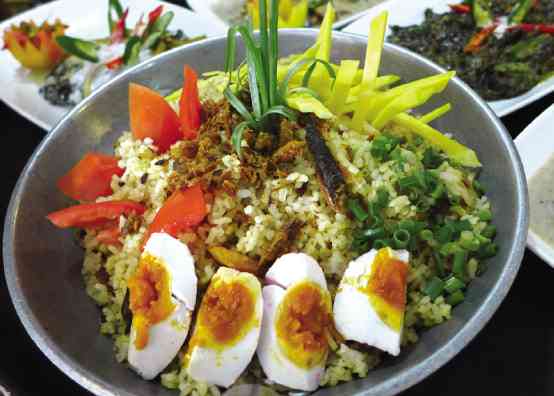
A place to discover in Bicol province is Misibis Bay along the southern tip of Cagraray Island in Bacacay, Albay. It’s a resort with first-class amenities and its own beaches and coves, choice villas with private pools and a casino.
The resort is now managed by Enderun Colleges, its hospitality training school providing the personnel. Among them is resident manager Lisa Zakharka, a graduate of International Hospitality Management who has had extensive experience here and abroad.
City tour
But before we proceeded to the resort, our hosts decided to give us a tour of Legazpi. Mayon Volcano wasn’t completely visible that day, showing only her “legs” and the outline of its world-famous peak against a cloudy shroud. We also revisited the Church of Cagsawa ruins (which looked much taller the first time we saw it years ago), and the Embarcadero or waterfront where the whale sharks detoured from Donsol early this year, but were scared off when water training exercises were held in the area.
For a taste of local cuisine, we were taken to 1st Colonial Grill on Rizal Street. The showpiece was tinutungan na manok, chicken cooked in milk from grated coconut toasted in charcoal. It reminded us of the kulawo in Quezon, pickled banana heart or eggplant dressed in smoky coconut milk.
What followed was a parade of standard Bicol food—the gabi (taro) leaf concoctions, shredded for laing and formed in packets for the pinangat and the Bicol Express, with the spiciness tempered.
The Bicol Express took on the “more pork than green chili” version of what is originally gulay na lada or chili cooked in coconut milk. Maybe eateries should have an original version available in case the adventurous or a true-blue Bicolano comes to eat.
1st Colonial Grill is also known for tinapa rice, a hodgepodge of smoked fish, salted eggs, green mangoes and tomatoes. It seemed like a Bicolano take on the Thai bagoong rice. But the new thing for us was the chili ice cream that had a creamy, fruity flavor, and then a jolt of heat at the throat.
There were also other flavors to remind one of Bicol—the tinutong with its smoky aftertaste, and the pili ice cream where the nut praline is strewn on top of a vanilla base.
We hardly had time to digest all these when we were brought to the local halo-halo favorite—DJC, which started in Tiwi, a town in Albay noted for its hot springs and geothermal facilities. Perhaps the heat needed a contrasting coolness, and so the creamy halo-halo with cheese was born.
Specialties
We also had a taste of three other Bicol specialties—the toasted siopao which is said to have started in the region; the pili in salty and sweet variations; and the malunggay pan de sal that has likewise become a hit all over the country.
Finally, on to Misibis Bay. A bridge connects Cagraray Island to Legazpi, well-paved winding roads lined with solar-powered street lights leading to the resort. But on reaching an elevated area, the van stopped. The mystery was short-lived, as we espied colorful bean bags and tables filled with cheese, canapes and wine glasses. It was cocktail hour at this site called Five Views, which offered a sprawling vista of three mountains, including the still-shrouded Mayon, the waters beyond and the rolling hills.
Our welcome dinner was at the resort’s Spice Market restaurant; our table was dressed up with creative centerpieces on the two nights we were there. We savored kinilaw na tanguigue, sinigang na hipon, laing, lumpiang ubod, seafood paella, cochinillo, and a version of Bicol Express that this time had seafood.
There was also turon leche flan, creamy and crunchy, which should have been enough as dessert, but the guinataang halo-halo was offered as well. It was a filling day.
Sedate setting
Breakfast was supposed to be at the Marina but the winds were so strong. There was a more sedate setting at the garden area by the pool, where we partook mostly Western breakfast fare, reminding us that we were at a resort hotel: breads freshly baked, eggs cooked to order, imported cheeses, hams and sausages, fruits both freshly cut and juiced.
Before leaving the next day, breakfast had more Filipino choices such as the beef tapa made by the staff.
Lunch was waiting at a private cove, one of the settings available to guests; we hopped on a boat to reach it. We washed our hands in seawater before and after eating the perfectly grilled pork belly, beef ribs, prawns and steamed mud crabs with rice, matching dipping sauces and grilled vegetables.
We had international cuisine for our last dinner: escargot baked out of the shell; rich-tasting prawn bisque; salmon salad on toast; tenderloin steak with Pinot Noir jus; chocolate molten lava cake; and the restaurant’s version of chili ice cream. Wines were also relished from day one—the Sauvignons, Pinot Noirs, Cabernet Sauvignons pouring at every meal, as expected of a good resort.
E-mail the columnist at [email protected].














































